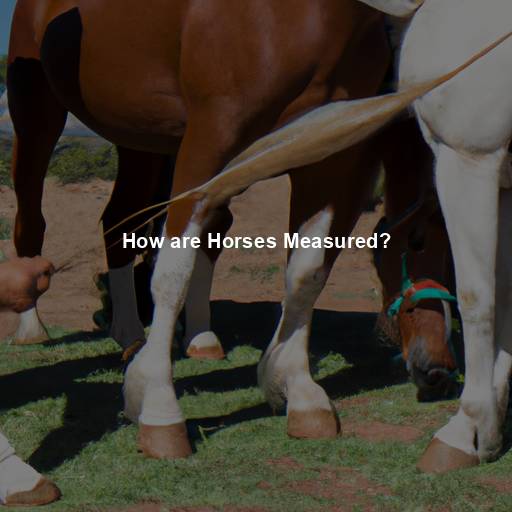How are Horses Measured?
Last Updated on July 31, 2023 by Evan
Contents [hide]
- 1 Understanding the Measurement of Horses
- 2 Measuring Height: Hands and Withers
- 3 Measuring Weight: The Importance of Knowing
- 4 Measuring Length and Other Dimensions
- 4.1 Measuring Length: Evaluating Proportions and Structural Integrity
- 4.2 Evaluating Chest Girth: Assessing Heart Girth and Body Condition
- 4.3 Understanding Cannon Bone Measurement: Assessing Structure and Conformation
- 4.4 Assessing Hip Height: Gauging Overall Size and Conformation
- 4.5 Additional Measurements: Tail Length and Facial Proportions
- 5 The Role of Equine Measurements in Horse Care and Management
- 6 FAQs: How are horses measured?
- 6.1 What is the standard unit of measurement for horses?
- 6.2 How is the height of a horse measured?
- 6.3 Why is the height of a horse measured in hands?
- 6.4 How accurate is measuring a horse in hands?
- 6.5 Are there different categories or classifications based on horse height?
- 6.6 Can horses grow taller after they are measured?
Understanding the Measurement of Horses
Horses have captivated human beings for centuries with their grace, strength, and beauty. As equestrians and enthusiasts, we often find ourselves immersed in the world of horses, learning about their different breeds, unique characteristics, and various measurements. One question that frequently arises is how horses are measured. In this article, we will delve into the fascinating world of equine measurements, exploring the methods used to determine a horse’s height, weight, and other important dimensions.
The Importance of Measuring Horses
Before we dive into the specifics of how horses are measured, it is essential to understand why these measurements matter. Accurate measurements provide valuable information to horse owners, breeders, and trainers. They play a crucial role in determining a horse’s suitability for specific tasks, such as racing, jumping, or dressage. Measurements also aid in assessing a horse’s overall health, monitoring growth and development, and ensuring proper nutrition and care.
Measuring Height: Hands and Withers
When it comes to measuring a horse’s height, the term “hands” is commonly used. A hand represents four inches, and it is the standard unit of measurement for horses. The horse’s height is measured from the ground to the highest point of its withers – the ridge between the shoulder blades. A horse’s withers are considered the most accurate point for measuring height since they remain relatively consistent regardless of the horse’s head and neck position.
The Process of Measuring Height
When it comes to gauging the majestic stature of a horse, precision is key. Experts rely on the assistance of an essential tool in their arsenal: the measuring stick or measuring tape. With utmost care, the equine is positioned on level terrain, its noble head gracefully held in its natural position. The measuring stick, guided by a steady hand, is then placed at a perpendicular angle, making contact with the highest point of the withers—an endeavor that requires some finesse.
Importance of Height in Horses
Knowing a horse’s height is vital for various reasons. It helps determine the most suitable size of equipment, such as saddles, bridles, and blankets. Additionally, height plays a crucial role in classifying horses into different categories and divisions for competitions, breeding purposes, and record-keeping. By accurately measuring a horse’s height, we can ensure that it is appropriately paired with riders or used for specific equestrian disciplines.
Measuring Weight: The Importance of Knowing
Diving into the realm of equine wellness, deciphering a horse’s weight becomes an enigma just as puzzling as determining its height. This weighty matter holds the key to upholding the majestic creature’s holistic well-being, from managing its nutritional needs to calibrating medication quantities with precision. Yet, unraveling the numerical puzzle is no walk in the stable, with a tapestry of methods unveiling both strengths and wrestles along the way.
Weight Estimation Methods
-
Weight Tapes: Weight tapes are commonly used as a quick and convenient method to estimate a horse’s weight. These tapes are specially designed with measurements and calculations based on the horse’s girth, length, and height. By taking these measurements and following the instructions provided, the weight tape provides an estimation of the horse’s weight.
-
Weigh Bridges and Scales: Weigh bridges and scales are more accurate methods for measuring a horse’s weight. These devices are typically found in equine clinics, hospitals, or specialized facilities. The horse is led onto the scale or weigh bridge, and its weight is recorded.
Body condition scoring is an invaluable tool for horse owners and enthusiasts alike, serving as an indirect method of estimating a horse’s weight. By visually assessing the amount of fat covering the horse’s ribs, spine, and other bony prominences, an estimate of their weight can be obtained using standardized scoring systems. Although it’s important to note that this method doesn’t provide an exact weight measurement, it offers tremendous value in monitoring weight fluctuations and keeping track of the horse’s overall body condition. With this tool at your disposal, you can ensure that your horses are in peak condition and well cared for.
Importance of Weight Measurement
Ensuring the precise measurement of a horse’s weight is absolutely paramount when it comes to their overall welfare and upkeep. Why? Well, it’s all about striking that perfect balance between feeding them just the right amount of nourishment and ensuring they receive the proper amount of supplemental support. Moreover, being able to calculate medication dosages on point is crucial, especially for equine-specific treatments like dewormers and therapeutic drugs.
Measuring Length and Other Dimensions
While height and weight are the primary measurements used for horses, other dimensions are also essential for evaluating their conformation and overall physical characteristics. These measurements include:
When we talk about the length of a majestic horse, we are referring to the measurement from the proud point of its shoulder to the regal point of its well-defined hindquarters. This measurement goes beyond being a mere number, revealing insights into the horse’s remarkable body proportions and the harmonious alignment of its sturdy skeletal structure. Understanding the length of a horse is truly getting a glimpse into the graceful symphony of nature’s design.
- Chest Girth: The chest girth measurement is taken around the widest part of the horse’s chest, just behind the front legs. This measurement helps determine the horse’s heart girth, which is essential for fitting harnesses and determining body condition.
When it comes to assessing a horse’s bone structure and leg conformation, one cannot overlook the significance of the cannon bone measurement. This measurement, taken from the knee or hock to the fetlock joint, unravels a plethora of valuable information that leaves both experts and enthusiasts mesmerized. As this anatomical feature plays a vital role in determining a horse’s overall soundness and athletic potential, its measurement has become a subject of great intrigue and perplexity among the equestrian community. So, if you find yourself captivated by the enigmatic world of equine anatomy, look no further than the cannon bone measurement to unlock some truly tantalizing secrets.
When it comes to evaluating a horse’s stature and structure, one crucial factor to consider is its hip height. This particular measurement is obtained by determining the distance from the ground to the uppermost point of the horse’s hip bone. By assessing the hip height, one gains valuable insights into the animal’s overall height and conformation, thus enhancing our understanding of its physical attributes.
When it comes to evaluating a horse’s physical attributes, it goes beyond just height and weight. Additional measurements play a crucial role in creating a comprehensive assessment that can be used for various purposes such as competitions, breeding assessments, and maintaining detailed records. These measurements add an extra layer of complexity, enabling a more holistic understanding of the horse’s physique and performance potential.
Measuring Length: Evaluating Proportions and Structural Integrity
The length measurement of a horse provides valuable insights into its body proportions and skeletal structure. By measuring from the point of the horse’s shoulder to the point of its buttocks, we can assess the overall balance and harmony of its body. A well-proportioned horse will exhibit a harmonious length that contributes to its overall athletic potential and soundness.
Evaluating Chest Girth: Assessing Heart Girth and Body Condition
The chest girth measurement is taken around the widest part of the horse’s chest, just behind the front legs. This measurement helps assess the horse’s heart girth, which plays a crucial role in fitting harnesses and determining body condition. A horse with a well-developed chest and ample heart girth is typically indicative of strength and stamina. Monitoring changes in chest girth over time can also provide insights into a horse’s body condition and overall health.
Understanding Cannon Bone Measurement: Assessing Structure and Conformation
When it comes to evaluating a horse’s physical structure, one cannot overlook the enigmatic measurement of the cannon bone. This peculiar metric, taken from the knee or hock to the mysterious fetlock joint, unveils profound insights about a horse’s leg conformation and bone structure. The key lies in achieving a harmonious cannon bone length, where perplexingly, a delicate balance is struck, influencing the horse’s athleticism and soundness. Any deviations from this cryptic ideal herald a complex tapestry of potential conformational issues or perhaps an enigmatic predisposition to specific injuries that leaves us pondering the intricacies of equine physiology.
Assessing Hip Height: Gauging Overall Size and Conformation
The hip height measurement is taken from the ground to the highest point of the horse’s hip bone. It helps assess the horse’s overall height and conformation. Horses with well-developed hip bones and a proportionate hip height often possess a balanced and powerful hindquarters, which are essential for athletic endeavors such as jumping, dressage, or racing. Hip height measurement is particularly important when evaluating horses for specific disciplines or when assessing their suitability for breeding.
Additional Measurements: Tail Length and Facial Proportions
When evaluating horses, it is customary to focus on fundamental measurements such as height, weight, length, chest girth, cannon bone, and hip height. However, delving deeper into the intricacies of equine assessments reveals a few lesser-known measurements that offer invaluable glimpses into a horse’s conformation and physical qualities. These supplementary measurements add a layer of complexity and depth to understanding the essence of these majestic creatures.
When it comes to equine beauty, one cannot ignore the enigmatic allure of tail length. Like a mesmerizing dance, the tails of horses sway with captivating grace, defying conventions and embracing individuality. While not a definitive measure of prowess or athleticism, the length of a horse’s tail is a coveted attribute, playing a vital role in the ethereal tapestry of their majestic presence.
The untamed allure of a horse’s face lies in the enigmatic harmony of its proportions. Delicately balanced, with a forehead that reveals secrets of lineage, the distance between its eyes determines the depth of its gaze, while a muzzle, unique in length and shape, whispers tales untold. By unraveling these intricate facial features, we unlock the hidden truths of a horse’s breed and the indomitable spirit that resides within.
When it comes to assessing a horse’s physical prowess, height and weight are just the tip of the iceberg. By delving deeper into additional measurements, we unlock a treasure trove of valuable information that paints a fuller picture of their capabilities, strengths, and areas that might warrant extra scrutiny. These holistic insights give us a nuanced understanding of their potential and guide us in providing the utmost care and support they need to thrive. So, let’s dive beneath the surface and explore the mysteries that lie within these intricate measurements.
The Role of Equine Measurements in Horse Care and Management
The world of horse care and equestrian pursuits is a complex and nuanced one, where every little detail can make a big difference. One such detail that holds paramount importance is equine measurements. These measurements, when done accurately, can act as guiding lights on the path of decision-making, be it regarding training methods, nutritional needs, gear selection, or overall horse well-being. Join us as we delve into the perplexing and ever-necessary world of equine measurements, where precision and detail reign supreme.
Equipment Fitting: Ensuring Comfort and Performance
Ensuring a horse’s utmost comfort and optimum performance can be quite the enigma, as the puzzle of finding the perfect fit for their gear unfolds. A harmonious combination of measurements such as height, chest girth, and body length will unlock the secret to selecting the most appropriate saddles, bridles, blankets, and other equine essentials. Steering clear of ill-fitting equipment is crucial, as the perplexing consequences of discomfort, restricted movement, or even potential injury could darken the horse’s path. By embarking on the quest of taking precise measurements and carefully matching them to the horse’s unique dimensions, owners hold the key to unlocking a world where their majestic equines can thrive in comfort and perform at their absolute best.
Nutrition and Diet: Tailoring Feeding Programs
When it comes to nourishing our noble steeds, deciphering their weight and physique becomes a paramount puzzle to solve. Why, you might wonder? Because it holds the key to crafting a feeding regimen that suits their individual needs. By getting a precise measurement of their weight, we can decipher the ideal concoction of nourishment – be it feed, forage, or supplements – to maintain their overall health and well-being.
Health Monitoring: Detecting Changes and Potential Issues
Keeping a close eye on a horse’s physical measurements is crucial for maintaining their well-being. From height to weight and everything in between, these metrics offer valuable insights into their overall health. Sudden deviations in these measurements may raise perplexing concerns about underlying health problems or changes in their body condition. By establishing a baseline through initial measurements and consistently tracking subsequent changes, horse owners and caretakers can effectively detect any potential issues and promptly seek proper veterinary attention.
Performance Assessment: Evaluating Athletic Potential
Equine measurements, including height, length, cannon bone, and hip height, are invaluable when assessing a horse’s athletic potential. These measurements help determine a horse’s suitability for specific equestrian disciplines, such as jumping, dressage, or racing. They also aid in evaluating a horse’s conformational strengths and weaknesses, which can impact its ability to perform certain tasks effectively. Accurate measurements contribute to making informed decisions regarding training, competition, and the selection of suitable breeding partners.
FAQs: How are horses measured?
What is the standard unit of measurement for horses?
Did you know that horses are measured in units called “hands,” with one hand being equal to four inches? When determining a horse’s height, it’s measured from the ground up to the highest point of its withers, which is the ridge between its shoulder blades. It’s fascinating how these magnificent creatures are quantified in such a unique and specific manner.
How is the height of a horse measured?
When it comes to assessing a horse’s stature, a peculiar tool called a “hand” enters the equation. This measuring stick is employed to gauge the height of the horse, specifically by positioning it alongside the withers in a perfectly upright stance. The measurement itself spans from the earth’s surface to the withers’ acme, and the total number of hands is deemed indicative of this equine attribute. An intriguing method indeed, confounding yet fascinating.
Why is the height of a horse measured in hands?
Throughout history, humans have relied on innovative ways to measure horses’ heights, and the timeless practice of using hands as a unit of measurement is a testament to our resourcefulness. In an era when complexity often reigns supreme, this traditional method has stood the test of time, providing a simple and reliable way to gauge a horse’s stature. From ancient times to the present day, there is a beauty in the continuity of using our own hands as a benchmark, allowing for an intuitive connection between humans and these majestic creatures. Embracing this age-old technique ensures that we can navigate the vast world of horse measurements with ease and clarity.
How accurate is measuring a horse in hands?
Measuring a horse in hands provides a relatively accurate measurement of its height. However, it’s important to note that there can be some slight variations in measurements depending on the precision of the measuring stick and technique used. Additionally, factors such as the horse’s stance or uneven ground can affect the measurement. Nevertheless, when done carefully and consistently, measuring in hands can give a reliable approximation of a horse’s height.
Are there different categories or classifications based on horse height?
When it comes to measuring horses, we enter a realm of height classifications that can leave us feeling like we’ve fallen into a labyrinth of equestrian wonder. From ponies to cobs and mighty horses, each category seems to defy easy explanation. Here’s a tip to unravel the enigma: ponies usually stand under 14.2 hands, cobs gallantly occupy the 14.2 to 15.2-hand range, and horses majestically tower above 15.2 hands. Of course, keep in mind that these distinctions might flex their boundaries depending on the whims of regional and breed-specific standards. So saddle up and prepare to navigate this mystifying terrain of equine dimensions!
Can horses grow taller after they are measured?
The majestic equine beings we call horses have their growth spurts in their early years, with their height usually stabilizing around 4 to 5 years old. Nevertheless, the mystical realm of equine physiology allows for the odd straggler who might experience some gentle upward growth until the age of 6 or 7. Thus, if one were to measure these untamed creatures at a young age, one might be surprised by a smidgen of extra height as they blossom into their magnificent selves. Yet, let us not be fooled, for this additional growth is often but a mere whisper, as most horses gallantly reach their full height before they bid adieu to their youthful days.







